COVID-19 Response
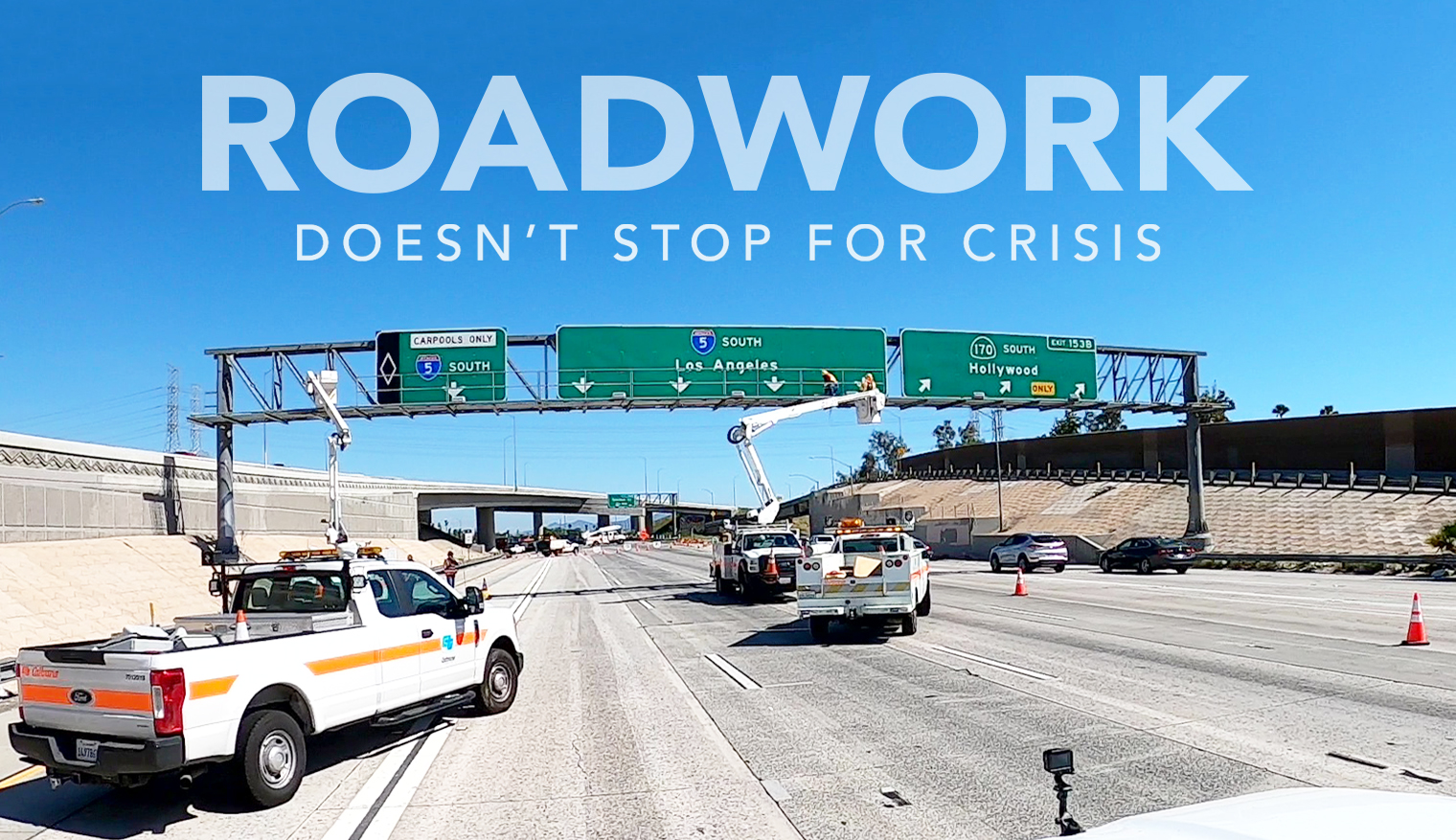
Pandemic Forces Adjustments, but Most Projects, Repairs Proceed as Planned
The global coronavirus pandemic has forced all California government agencies to quickly adapt in how they serve and protect the public.
Caltrans, as steward of the state’s highway system, is responding to the challenge posed by this crisis.
Following Gov. Gavin Newsom’s stay-in-place Executive Order on March 19, Caltrans has focused on fulfilling its responsibilities of managing the day-to-day operations of the state transportation network while carrying through the systemwide improvements promised to taxpayers and the traveling public by the Road Repair and Accountability Act of 2017 — Senate Bill 1.
Not only has Caltrans continued most construction contracts despite the logistical problems caused by the coronavirus, it has taken advantage of opportunities to perform work with minimal impact to travelers.
By mid-April, Caltrans’ contractors were able to expand the construction work windows on more than 100 projects throughout the state while implementing CDC guidelines. With weekday highway traffic down by about 35 percent since stay-at-home orders were issued, Caltrans’ contractors and maintenance crews consequently had more flexibility in their work schedules.
The added flexibility provided opportunities to alter work from night to daytime operations, helped crews work safer and allowed Caltrans maintenance forces to team up with construction colleagues to perform myriad tasks that would otherwise occur over many work shifts and additional lane closures. With lighter traffic, lane closures have less of an impact on travel times, allowing more work to occur at all hours, including rush hour periods when work is typically prohibited.
Going into the pandemic, Caltrans had more than 700 active construction contracts. On April 28, more than six weeks after the governor’s Executive Order, 96 percent of 714 active construction projects were proceeding as planned. There were 29 projects that were suspended for contractor concerns related to the COVID-19 crisis.
Maintenance activities have continued mostly uninterrupted during the crisis. Caltrans field crews continue to repair roadways, clean culverts, keep lighting and signals working, install new guardrail and other road-related work critical to the health of the California’s vast transportation system.
These duties are being carried out despite major changes at many Caltrans workplaces prompted by the virus. To minimize the threat of illness, many employees in Caltrans’ 12 regional districts and Sacramento headquarters are now telecommuting, foregoing in-person meetings for web-hosted ones and modifying how they go about doing their jobs. Other staff members whose jobs have been declared essential have remained at their posts in the office and in the field, directing or conducting Caltrans’ key operations while practicing Centers for Disease Control guidelines for social distancing, sanitizing work areas, personal hygiene and face coverings.
Below are specific examples of projects and other Caltrans operations that have proceeded or been altered during the pandemic.
Major S.F. bridge project completed ahead of schedule
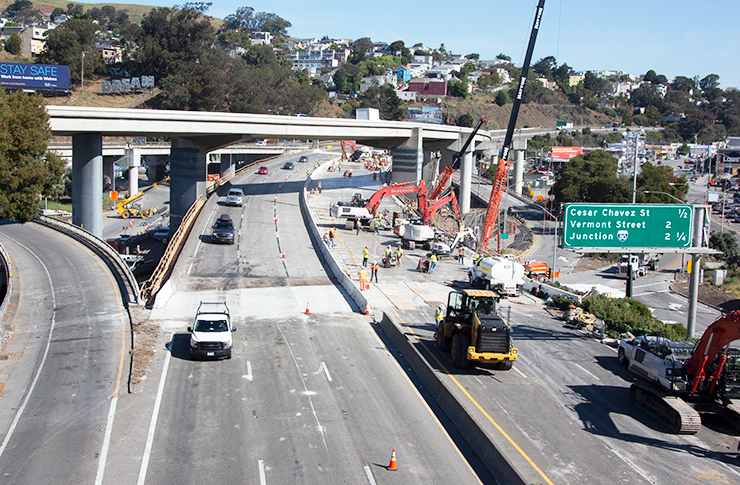
In San Francisco, a few miles south of downtown, crews and contractors capitalized on lighter traffic to replace the U.S. Highway 101 bridge deck at Alemany Circle. The 800-foot-long deck, built about 70 years ago, was completely replaced in less than two weeks.
The Alemany project originally was scheduled to start in July, work that would have been a major source of inconvenience and stress for tens of thousands of commuting motorists and other highway users. This stretch of U.S. 101 is a key artery for connecting the city to the north and the peninsula to the south. Because of the governor’s stay-at-home directives and project planners’ adaptive planning, the bridge deck replacement work began April 24, more than two months ahead of schedule, and was substantially completed on May 2. Ultimately, the minimization of public inconvenience outweighed the cost to accelerate this work.
Caltrans regional District 4 also made sure the public was kept informed throughout the project. Cameras provided 24-hour live video of the construction from four angles. Bay Area television stations frequently tapped into those Caltrans live streams during their news reports about the project, and journalists were fed updates via a dedicated information link on the District 4 website that provided Caltrans-supplied photographs, animations, maps and graphics. Caltrans also made extensive use of social media during the project.
Shutdown of I-5 for L.A. bridge demolition goes smoothly
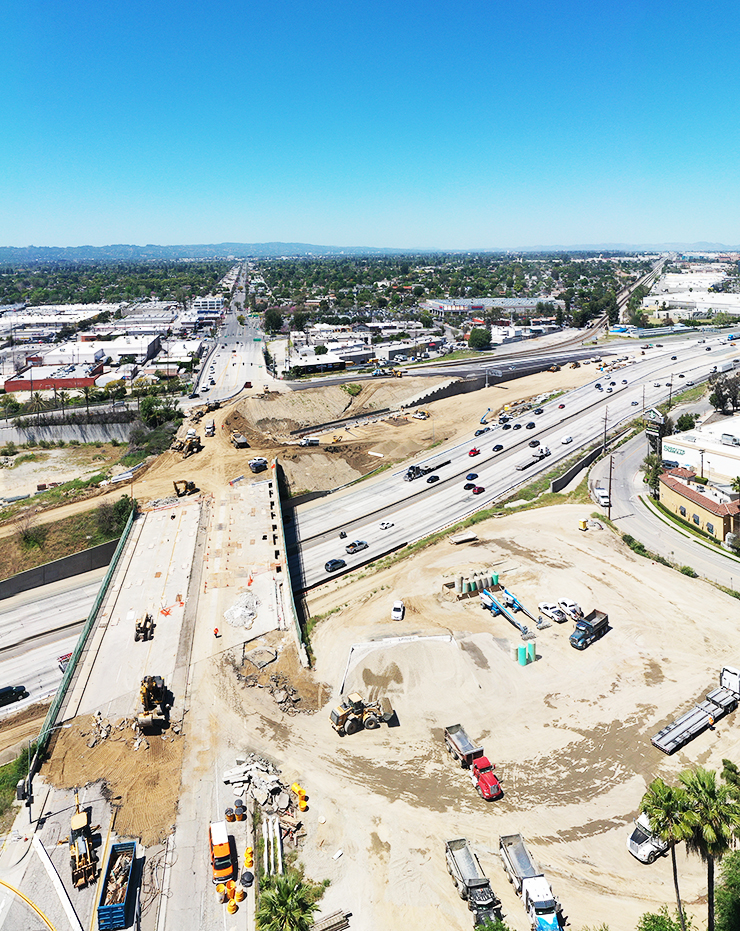
At the same time in Los Angeles County, Caltrans District 7 workers and contractors tore down the 70-year-old Burbank Boulevard bridge over Interstate 5. A modern, wider bridge will rise in its place over the coming months and allow room for carpool lanes in both directions of the major urban freeway, and add bicycle lanes and wide sidewalks across the overpass.
The demolition project required the complete closure of Interstate 5 from 2 p.m. Saturday, April 25, until 2 a.m. Monday, April 27. The full-closure approach sped up work, increased safety for motorists and workers, and represented the most efficient use of taxpayer funds. Its impact upon traffic, which during normal times would have been substantial, was made more bearable by the fact that nearby businesses were closed due to the pandemic. The full closure also allowed Caltrans maintenance crews to do a significant amount of maintenance work adjacent to the construction project.
Caltrans staff documented the weekend work by compiling photographs and videos, some of them taken by drones, and made images available via a dedicated webpage.
Rules eased to allow vital supplies to get through
Caltrans adapted other parts of its operation to aid in the fight against the pandemic. Here are some of the major moves:
Temporary Permits
On April 13, following the Governor’s declaration and activation of the Federal Disaster Relief and Assistance Act, Caltrans began issuing the “Special Permits During Periods of National Emergency.” These permits increase the trucks’ haul weight limits, allowing those vehicles to transport more pandemic-related essential goods.
The permits temporarily raise the maximum allowable gross vehicle weight from 80,000 to 88,000 pounds.
To expedite the permit issuance process, Caltrans performed advance review and analysis of all bridges on major California freight routes to determine their truck weight restrictions. Some of the reviewed routes included Interstates 5, 15, 80, 405 and 710, U.S. Highway 101, and State Routes 60, 91 and 99. To qualify for special permits, the overweight trucks must be hauling “essential goods” such as medical supplies and equipment related to the testing, diagnosis and treatment of COVID-19; food; fuel; and construction supplies for pandemic-necessitated facilities.
Food Trucks
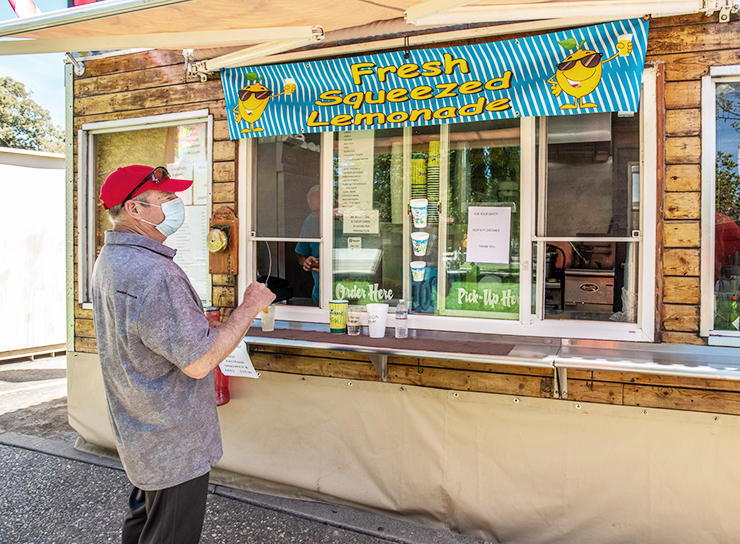
On April 19, Caltrans began allowing temporary operation of food trucks in state rest areas. This initiative provides access to prepared meals for truck drivers and other motorists, and gives food truck operators an opportunity to soften the blow from business they might have lost during the pandemic.
To operate at one or more of the state’s 86 rest areas, food truck operators must apply for and be granted a temporary encroachment permit. Because food trucks are licensed locally, each operator must be licensed and permitted by the local health inspector from the jurisdiction where they plan to operate, and need to specify the rest areas where they want to sell “to go” food.
Food truck operators are responsible for all waste cleanup and removal, must follow all food-safety rules, and maintain social distancing among employees and customers.
Applicants can submit requests to operate their food trucks at specific rest areas, and truckers and others can see what food trucks are up and running at rest areas by visiting a new landing page on the Caltrans website.
Teaming Up for Safety
In light of a tremendous surge in speeding on state roads, Caltrans launched a joint campaign with the California Highway Patrol (CHP) and the California Office of Traffic Safety to urge drivers in the state to slow down.
From March 19, when the state’s stay-at-home order began, to April 19, the CHP reported issuing 2,493 citations statewide for speeding more than 100 mph, compared with 1,335 during the same period last year. That 87 percent increase coincided with what Caltrans measured as a 35 percent average decline in traffic volume on state roads.
California’s “Move Over” law continues to be in effect and requires all drivers to move over a lane, or if unable to do so safely, slow down when they see amber flashing lights on Caltrans vehicles, law enforcement and emergency vehicles, and tow trucks.
Changeable Message Signs
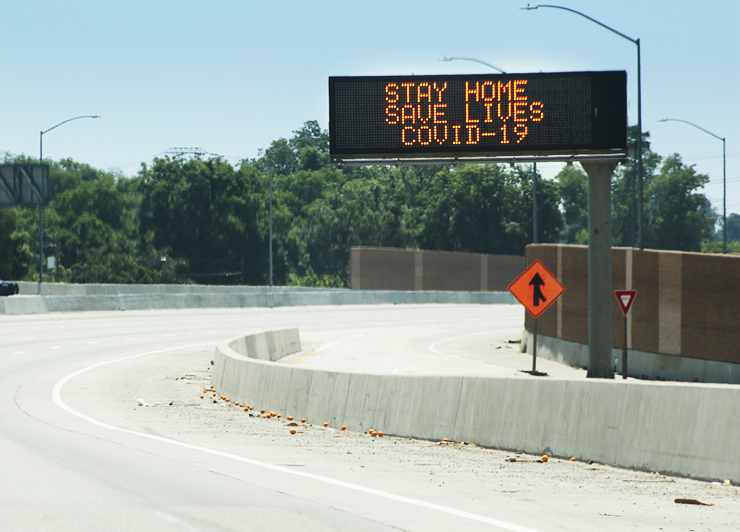
Caltrans’ changeable message signs have been used as a high-visibility strategy to alert travelers about behaviors that keep them and others who use the state highways safe. As part of the state agencies’ joint effort against speeding, Caltrans’ 700-plus changeable message signs promoted roadway safety by urging motorists: “If you must travel, do not speed” and “Keep essential workers safe. Do not speed.”
Additional message signs are reminding the public about COVID-19 preparedness, and about conditions such as virus-prompted closures of state highway facilities such as state parks and beaches.
Lighter traffic creates window of opportunity for maintenance work
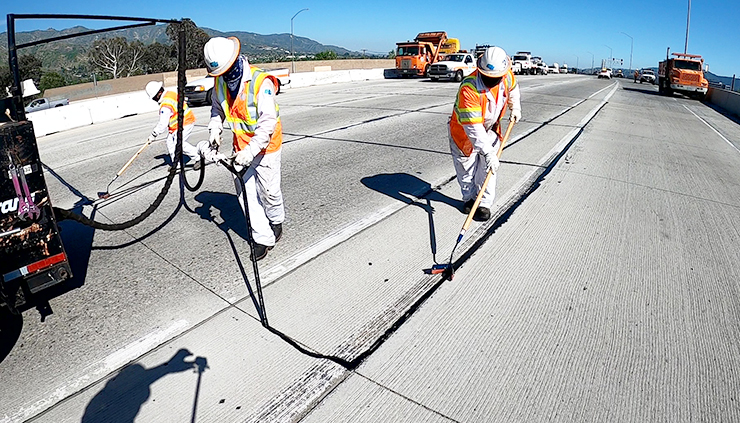
With vehicular traffic reduced as much as 35 percent during the pandemic, especially during the earliest weeks of stay-at-home directives, Caltrans’ Maintenance division has taken advantage in various ways. In the Central Valley’s District 6, for example, portions of State Routes 41 and 99 were closed during daylight hours on weekdays so that crews could work on lighting standards, replace signs, refresh striping, fix potholes and sweep. In normal times, those tasks often are relegated to nights and weekends.
Maintenance workers continue to do what's necessary to keep the State Highway System open and ensure the unimpeded flow of essential goods such as medical supplies and groceries. Field crews continue to provide emergency traffic control for vehicle crashes; perform emergency pavement, lighting and sign repairs; and clean and repair drainage facilities, all while maintaining 24/7 availability.
As is the case with other Caltrans divisions, administrative work is largely being done remotely. Teleworking engineers are learning how to use online platforms that keep them connected, saving time and reducing the need to travel, which in turn reduces their “carbon footprint.”
Although most of the office staff has been telecommuting, Caltrans mechanics continue to work in maintenance shops and in the field. With about 12,000 pieces of equipment in the fleet, maintaining and repairing that inventory continues to be a priority during the pandemic while also meeting manufacturing-production run goals.
However long this virus lasts, Caltrans’ 20,000-plus employees have mobilized as a single force dedicated to keep California moving.
Sources: Caltrans Division of Equipment; Jesse Bhullar, Chief, Caltrans Division of Traffic Operations; Rachel Falsetti, Chief, Caltrans Division of Construction; Dennis Agar, Chief, Caltrans Division of Maintenance; Michael Comeaux, District 7 Public Information Officer; Vince Jacala, District 4 Public Information Officer; Michael Mayor, Deputy Division Chief, Caltrans Division of Equipment
- Director's Message
- Mile Markers
- COVID-19 Response
- SB 1: Progress Made, Challenges Remain
- Bridge, Other Inspections Taking to the Skies
- Safety Plan Seeks to Protect Roadway Users
- Report Maps Future Freight Strategy in State
- Canyon Bridge Network Rebuilt After Slides
- Caltrans Exceeds Small Business Goals
- Busy Year at Capitol Yields New Transportation Laws
- Mileposts
- Pay-Per-Mile Remains Viable Alternative for Transportation Funding
- Partnership Program Pitches In With a Hitch

